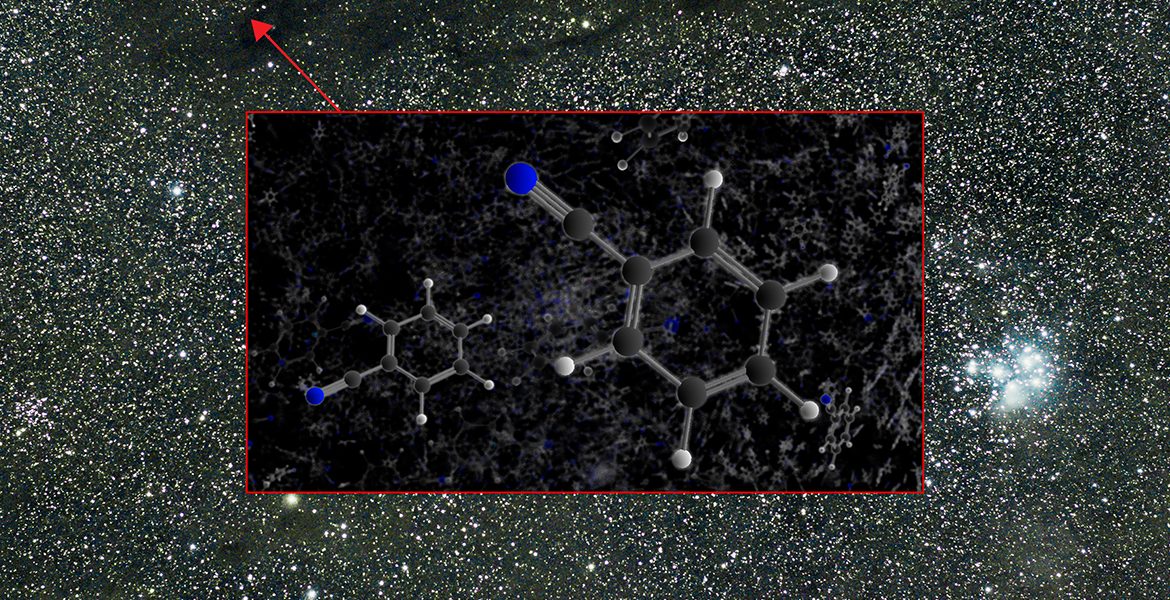Mystery Solved! Discovery of Organic Molecules Explains Universe's Infrared Glow
NATIONAL HARBOR, Md. — The universe is filled with faintly glowing infrared light, and for decades, astronomers have been trying to figure out why. But now, they've finally determined the source of this strange cosmic radiation: It is emitted by an organic molecule called benzonitrile, which seems to permeate every part of the known universe. The researchers presented their findings here at the 231st meeting of the American Astronomical Society.
Benzonitrile belongs to a class of molecules known as polycyclic aromatic hydrocarbons (PAHs). While that may sound like a classification of molecules that smell, the term "aromatic" actually has nothing to do with scent in this case. Rather, the term is used in organic chemistry to describe the molecules' ring-like shape. Scientists have discovered hundreds of kinds of PAH molecules on Earth, and astronomers have long suspected that PAHs could be responsible for the mysterious infrared glow in space. But no one had ever found concrete evidence that they exist in outer space — until now.
Using new data from the Green Bank Telescope (GBT) in West Virginia, astronomers have discovered, for the first time, "the convincing radio fingerprints of a close cousin and chemical precursor to PAHs, the molecule benzonitrile," officials at the National Radio Astronomy Observatory (NRAO) in Charlottesville, Virginia, said in a statement. The research team that made this discovery was led by NRAO astrochemist Brett McGuire. [8 Baffling Astronomy Mysteries]
Though the researchers believe benzonitrile is responsible for the mysterious infrared radiation, they discovered it using a telescope that measures radio waves, which make up a different portion of the electromagnetic spectrum. McGuire and his team were using GBT — a radio telescope with an enormous, 328-foot (100-meter) dish — to look at the radio spectrum coming from the Taurus Molecular Cloud, a star-forming nebula located about 430 light-years from Earth, when they saw telltale spikes in their data indicating the presence of benzonitrile.
"These new radio observations have given us more insights than infrared observations can provide,” McGuire said in the statement. "Though we haven't yet observed polycyclic aromatic hydrocarbons directly, we understand their chemistry quite well. We can now follow the chemical breadcrumbs from simple molecules like benzonitrile to these larger PAHs."

PAHs are abundant on Earth and can be found in foods, medications, cigarette smoke and some air pollutants. But this is the first time anyone has seen such a molecule in space using radio astronomy. Although PAHs are large molecules, they're just tiny grains of dust from a cosmic perspective. Benzonitrile's "unique structure enabled the scientists to tease out its distinctive radio signature, which is the 'gold standard' when confirming the presence of molecules in space," NRAO officials said.
Though scientists thought that PAH molecules would form around hot, evolved stars, the benzonitrile was detected in a cold molecular cloud. The benzonitrile that the researchers detected was also four times more abundant than the amount they calculated using chemical models.
Get the Space.com Newsletter
Breaking space news, the latest updates on rocket launches, skywatching events and more!
"The mismatch between observations and model shows that, despite the low observed abundance of benzonitrile, its detection remains important in constraining chemical models," Christine Joblin, a molecular astrophysicist at the University of Toulouse in France, and José Cernicharo, of the Institute of Materials Science of Madrid, wrote in a perspectives piece accompanying a new research paper describing the findings.
Both the paper and the accompanying perspectives piece were published today (Jan. 12) in the journal Science.
Email Hanneke Weitering at hweitering@space.com or follow her @hannekescience. Follow us @Spacedotcom, Facebook and Google+. Original article on Space.com.
Join our Space Forums to keep talking space on the latest missions, night sky and more! And if you have a news tip, correction or comment, let us know at: community@space.com.

Hanneke Weitering is a multimedia journalist in the Pacific Northwest reporting on the future of aviation at FutureFlight.aero and Aviation International News and was previously the Editor for Spaceflight and Astronomy news here at Space.com. As an editor with over 10 years of experience in science journalism she has previously written for Scholastic Classroom Magazines, MedPage Today and The Joint Institute for Computational Sciences at Oak Ridge National Laboratory. After studying physics at the University of Tennessee in her hometown of Knoxville, she earned her graduate degree in Science, Health and Environmental Reporting (SHERP) from New York University. Hanneke joined the Space.com team in 2016 as a staff writer and producer, covering topics including spaceflight and astronomy. She currently lives in Seattle, home of the Space Needle, with her cat and two snakes. In her spare time, Hanneke enjoys exploring the Rocky Mountains, basking in nature and looking for dark skies to gaze at the cosmos.









